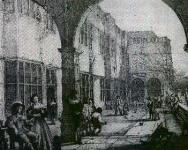The History of Modern Day Lawn Bowling and beyond. |
Coming Next- Drake! Legend or Myth? |
The
game of bowls enjoyed a brief respite in 1455 when Henry VI lifted the ban on
games within the City walls. That same year the capital saw the construction of
the first bowling alley and the first bowls explosion with greens and alleys
springing up with almost indecent haste. The alleys were of two kinds, one
simply a narrow single lane affair, situated at a convenient and suitable spot,
often between hedges or rows of trees. The other found mainly in London and
used more often than not for skittle type games, was a covered alley with a
laid wooden floor.
Although greens were being laid at many of the large country estates,
the majority, like the alleys, were constructed adjacent to inns and taverns, a
custom which was to give cause for even stricter controls upon the already
embattled game. Alleys perhaps because of their sitting, were to become the
stamping grounds of the gambling fraternity, drunks and low-life characters of
the day and these tawdry associations were to remain an unwelcome feature of
bowls for many years. The outdoor game, while carrying on as much as it had
done over the years, tended to be tarred with the same brush as the alley game
as bowls in general fell into disrepute and eventually paid the consequence.
The
year 1477 saw Parliament under Edward IV reinstating the ban on certain games
to commoners and introducing new and harsher measures to punish those who broke
the new Law. The Prison term rose from
six months to two years and also carried a fine of £10. Anyone allowing such games to
be played in his gardens or other place shall be Three Years imprisoned and
forfeit £20, the ruling continued. But those penalties were to prove
unsuccessful and almost impossible to enforce.
Like
many other Royal figures, Henry VIII, a keen sportsman, embraced the game of
bowls with great enthusiasm. Strutts Sports and Pastimes of the People of
England credits that somewhat forbidding roister with the laying of greens
at Whitehall Palace and reveals that the Kings privy purse expenses show that
he lost £4 10s (£4.50) at bowls to Mr
Fitzwilliam, the treasurer, on the 29th January 1530. Another entry,
two years later, finds Henry on the wrong end of a pairs match in which he and
a Mr Bayton lost £9 to Lord Wiltshire and a Lord Rocheford who were able to add
a further £35 5s (£35.25) to their winnings a few days later. The Kings obvious
enjoyment of the game, not to mention the added spice of a wager on the
outcome, failed to temper his view of the common mans shared enthusiasm for it.
In 1511 Henry
won the dubious distinction of becoming the first monarch actually to mention
the game of bowls by name (rather than the the all embracing `bowling games`)
in a statute confirming existing laws. The game of bowls, he declared was an
evil because the alleys are in operation in conjunction with saloons or
dissolute places, and bowling has ceased to be a sport, and rather a form of
vicious gambling.
Some eight years following the death of Henry VIII in 1547, Mary I
deprived even those of noble birth the right to play bowls with an act passed
at Westminster in 1555. A staunch Catholic, Mary , the daughter of Henry and
Catherine of Aragon, had married Phillip of Spain in 1554 and completely turned
the religious order of England on its head. Not without some cause, Mary saw
the bowling alleys and greens as being ideally suited as meeting places for men
of influence opposed to her views and beliefs. Unlike her father, Mary aimed
her act at some of the highest and mightiest in the land rather than the commoner.
After the Christmas of 1555, licences for Bowling granted under Henry were
declared `utterly void and of none effect` while the greens and alleys of which
Mary had become so suspicious were seen as attracting ``idle and misruled
persons` who held `divers and many unlawful Assemblies, Conventicles,
Seditions and Conspircies` whereby Robberies
and many other Misdemeanours ensued to the breach of their Highnesses peace. So
yet another stick had been found to wave in the face of bowlers, religious and
political intrique.

17th century bowls on the terrace, Bramshill House, Hants. The seated figure is considered to bear a close resemblance to Charles I, a bowler of some prowess. |
